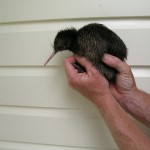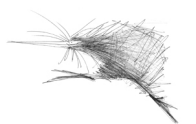Field techniques
Transmitters
The WHLF use radio transmitters to monitor a sample of approximately 15 kiwi at the Whangarei Heads.
These transmitters are each kiwi’s private radio station -they send out a beep signal on a particular channel. For example, Dallas at Taurikura is channel tx 36 (“tx” is short hand for transmitter).
The tx is attached to the kiwi’s leg with a baby band (same as those used in human hospitals) and the band is reinforced with a few rounds of electrical tape.
The kiwi soon get use to the tx - it must similar to wearing a watch for us – and carry on their business as usual.
We can then follow the movements of the kiwi by tuning into their radio channel and using a directional aerial (like an old TV aerial) to find out when he is.
T.T. the Wanderer was a great example of a monitored kiwi.
We use the transmitters to keep an eye, or an ear out, on where these kiwi are. But even better, the tx can tell us what they are up to.
The tx’s contain a mercury switch that senses movement - ie. how often the kiwi moves his leg. If there is no movement for 24 hours the tx signal changes to a rapid beep (mortality signal) meaning the tx has either fallen off or the kiwi is dead.
When the WHLF first started releasing kiwi at the Heads in 2004, the radio monitoring pretty quickly told us where we had wandering dog problems, and where dog killed kiwi (see Kauri Mt story). Without radio monitoring we wouldn’t have known that there was a dog problem or where it was.
We now have far fewer deaths from dogs as the local community have become much more aware of the need for good dog control – in part through the education of locals of the fact that they have kiwi in their backyard, and by radio monitoring some of kiwi.
More information on technology we use in the field:
-
About Chick Timers Chick timers are a valuable way to figure out when chicks are going to hatch.



![CropperCapture[6]](http://www.backyardkiwi.org.nz/wp-content/uploads/2010/03/CropperCapture6-150x150.jpg)
![CropperCapture[7]](http://www.backyardkiwi.org.nz/wp-content/uploads/2010/03/CropperCapture7-150x150.jpg)
![CropperCapture[8]](http://www.backyardkiwi.org.nz/wp-content/uploads/2010/03/CropperCapture8-150x150.jpg)

